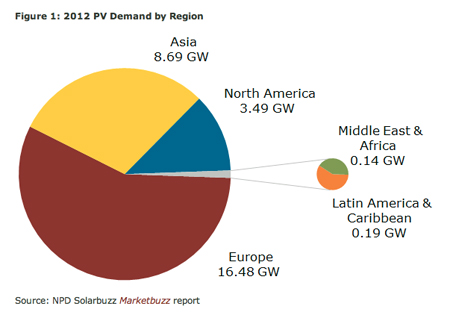Solar PV capacity passes 100GW as demand slows to 30GW. But its future is positive, say two new market reports.

The world’s cumulative solar photovoltaic (PV) electricity capacity surpassed 100 GW in 2012, achieving just over 101 GW, according to new market figures from the Brussels-based European Photovoltaic Industry Association (EPIA).
Craig Winneker, the EPIA’s Head of Political Communications, commented, “This global capacity to harness the power of the sun produces as much electricity energy in a year as 16 coal power plants or nuclear reactors of 1 GW each. Each year, the world’s PV installations reduce CO2 emissions by 53 million tons."
The surpassing of the 100 GW mark occurred in yet another year of what the EPIA called “strong global PV development”, with an estimated 30 GW connected to the grid and made operational in 2012, which would be approximately the same as the record level achieved in 2011.
Winneker continued, “These results are preliminary, and the 30 GW figure could be increased by an additional 1 or 2 GW when final numbers come in. Final results for the year will be published in May 2013, in EPIA’s annualGlobal Market Outlook for Photovoltaics 2013-2017.
EPIA President Winfried Hoffmann added, “No one would have predicted even 10 years ago that we would see more than 100 GW of solar photovoltaic capacity in the world by 2012. The photovoltaic industry clearly faces challenges but the results of 2012 show there is a strong global market for our technology. Even in tough economic times and despite growing regulatory uncertainty, we have nearly managed to repeat the record year of 2011.”
Underpowered?
Another solar power market analyst NPD Solarbuzz has also just produced a report on the sector’s performance in 2012 which generally agrees with the EPIA’s assessment of the global consumption of solar power, although the latter’s tone is less upbeat, stressing that “solar photovoltaic demand in 2012 had fallen short of 30 GW.”
The Santa Clara-based NPD Solarbuzz said that the annual growth rate of solar power consumption had declined to a 10-year low “as the industry prepares for emerging markets to drive new opportunities”.
Michael Barker, Senior Analyst at NPD Solarbuzz, said, “During most of 2012, and also at the start of 2013, many in the PV industry were hoping that final PV demand figures for 2012 would exceed the 30 GW level.”
“Estimates for the year during 2012 often exceeded 35 GW as PV companies looked for positive signs that the supply/demand imbalance was being corrected and profit levels would be restored quickly. Ultimately, PV demand during 2012 fell well short of the 30 GW mark.”

Europe on the wane
Solarbuzz NPD added that, despite an environment of declining incentives during 2012, Europe remained the largest regional market with 16.48 GW of PV demand, almost 60% of global demand during 2012, but less than its 68% figure in 2011 and 82% in 2010.
The second largest region for PV demand was Asia with 8.69 GW, stimulated by the growth of the Chinese market during the second half of 2012. PV demand from the Americas is now segmented across North America (US and Canada), and Latin America and the Caribbean.
The Americas provided 13% of global PV demand in 2012, or 3.68 GW. However, a large portion of PV demand from the Americas came exclusively from California, driven by Renewable Portfolio Standards and rebates. In fact, California provided more than one-third of all PV demand from the entire Americas region during 2012.
Despite falling short of 30 GW, PV demand during 2012 set another annual record for the industry. Indeed, the 29.0 GW of demand added during 2012 is nearly 30% of all installed PV capacity at the end of 2012. However, SolarBuzz commented that the demand level of 29.0 GW in 2012 should be compared directly to the level of supply that upstream manufacturers were expecting during the year.
“For supply and demand to have been balanced during 2012, end-market demand should have approached the 45 GW level,” said Barker. “This is 50% higher than actual PV demand in 2012, and reflects the lack of demand elasticity that characterizes the PV industry today. It also explains why even those companies that gained market-share in 2012 still ended up reporting significant operating losses.”
Optimistic forecast
At the EPIA, Reinhold Buttgereit, Secretary General, is maintaining a positive outlook in his blog on the Association’s website. He writes, “Last year was a turbulent one for the photovoltaic industry but even with the uncertainty facing PV it is clear that our technology is continuing its evolution to becoming a mainstream source of electricity.
“Europe’s domination of the PV market is coming to an end. In 2013 it is almost certain that the majority of new PV capacity in the world will be installed outside of Europe.”
Buttgereit was also positive about the general prospects for the sometimes-faltering technology: “While the global market for PV will continue to be stable… the driving forces will be in countries like China, the U.S., Japan and India. The PV market is becoming truly global.
“It is important that PV companies everywhere can compete on a level playing field so it is vital that competition in new markets is based on free and fair principles. This will be key to maintaining a healthy, sustainable growth for our technology.”





